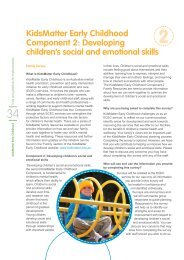Participant Workbook - KidsMatter
Participant Workbook - KidsMatter
Participant Workbook - KidsMatter
Create successful ePaper yourself
Turn your PDF publications into a flip-book with our unique Google optimized e-Paper software.
1<br />
component<br />
Positive school community<br />
<strong>Participant</strong> <strong>Workbook</strong>
Acknowledgement<br />
<strong>KidsMatter</strong> Australian Primary Schools<br />
Mental Health Initiative has been developed<br />
in collaboration with beyondblue, the<br />
Australian Psychological Society, the<br />
Principals Australia Institute and, with funding<br />
from the Australian Government Department<br />
of Health and Ageing and beyondblue.<br />
Disclaimer<br />
While every care has been taken in preparing<br />
this publication, Beyond Blue Ltd, the<br />
Australian Psychological Society Limited,<br />
Principals Australia Institute Inc and the<br />
Commonwealth of Australia do not, to the<br />
extent permitted by law, accept any liability<br />
for any injury, loss or damage suffered by<br />
any person arising from the use of, or<br />
reliance upon, the content of this publication.<br />
Important notice<br />
<strong>KidsMatter</strong> Australian Primary Schools Mental<br />
Health Initiative and any other <strong>KidsMatter</strong><br />
mental health initiatives are not to be confused<br />
with other businesses, programs or services<br />
which may also use the name ‘Kidsmatter’.<br />
Copyright<br />
© Commonwealth of Australia, 2011-12<br />
This work is copyright. Provided<br />
acknowledgement is made to the sources,<br />
schools are permitted to copy material<br />
freely for communication with teachers,<br />
staff, students, parents, carers or<br />
community members. You may reproduce<br />
the whole or part of this work in unaltered<br />
form for your own personal use or, if you<br />
are part of an organisation, for internal<br />
use within your organisation, but only<br />
if you or your organisation do not use<br />
the reproduction for any commercial<br />
purpose and retain this copyright notice<br />
and all disclaimer notices as part of that<br />
reproduction. Apart from rights to use as<br />
permitted by the Copyright Act 1968 or<br />
allowed by this copyright notice, all other<br />
rights are reserved and you are not allowed<br />
to reproduce the whole or any part of this<br />
work in any way (electronic or otherwise)<br />
without fi rst being given the specifi c written<br />
permission from the Commonwealth to<br />
do so. Requests and enquiries concerning<br />
reproduction and rights are to be sent to:<br />
Communications Branch<br />
Department of Health and Ageing<br />
GPO Box 9848, Canberra ACT 2601<br />
or via e-mail to:<br />
copyright@health.gov.au<br />
While the resources are available freely for<br />
these purposes, to realise the full potential<br />
of <strong>KidsMatter</strong> Primary, it is recommended<br />
that the resources be used with the<br />
appropriate training and support under the<br />
<strong>KidsMatter</strong> Initiative.<br />
Imagery<br />
The information and multimedia used in<br />
this publication are not intended to refl ect<br />
on the character or reputation of any<br />
persons pictured or identifi ed in this<br />
publication. The images are for illustration<br />
purposes only and any persons pictured or<br />
identifi ed are in no way associated with the<br />
subject matter of the publication.<br />
Aboriginal and Torres Strait Islander people<br />
are also advised that this publication may<br />
contain images or audio of deceased persons.<br />
Last updated in November 2012
Contents<br />
03<br />
06<br />
18<br />
22<br />
26<br />
<strong>KidsMatter</strong> Primary<br />
professional learning<br />
Session 1: Understanding mental<br />
health and wellbeing<br />
Session 2: Designing a positive<br />
school community<br />
Session 3: Relationships<br />
and belonging<br />
Session 4: The practices of<br />
a positive school community<br />
1<br />
component
<strong>KidsMatter</strong> Primary<br />
professional<br />
learning<br />
<strong>KidsMatter</strong> Primary professional learning<br />
uses a range of approaches to help<br />
schools work through the content of each<br />
of the four components. It’s important<br />
that the professional learning is delivered<br />
by a facilitator who has been trained by<br />
<strong>KidsMatter</strong> Primary. He or she will lead<br />
you through activities and discussions<br />
specifi cally designed to get you thinking<br />
deeply about the way your school supports<br />
student mental health and wellbeing.<br />
This professional learning is supported by<br />
a range of informative and engaging videos,<br />
which were made in collaboration with dedicated<br />
professionals and inspiring <strong>KidsMatter</strong><br />
Primary schools.<br />
Videos include commentary by mental health and<br />
education experts about what approaches work best<br />
in a school setting.<br />
They also showcase the stories and experiences<br />
of real schools engaging with <strong>KidsMatter</strong>, and the<br />
strategies they have found most effective.<br />
Component 1: Positive school community 03<br />
<strong>Participant</strong> <strong>Workbook</strong>
<strong>KidsMatter</strong><br />
Primary<br />
would like to thank the following experts and schools<br />
for their contribution to this professional learning.<br />
Assoc. Prof. Helen Cahill<br />
University of Melbourne<br />
Bob Bellhouse<br />
Educational Consultant<br />
Prof. Brian Caldwell<br />
Managing Director,<br />
Educational Transformations<br />
Kaye Dennis<br />
Educational Consultant<br />
Trial schools<br />
Broadford Primary School (VIC)<br />
Ithica Creek Primary School (Bardon, QLD)<br />
Groves Christian Primary School (Kingston, QLD)<br />
Focus group members<br />
Kim Butler, St Mary’s Primary School (Ararat, VIC)<br />
Inez French, Lumen Christi Primary School (Delacombe, VIC)<br />
Prof. Beverly Raphael<br />
ANU and University of<br />
Western Sydney<br />
Prof. Stephen Zubrick<br />
Telethon Institute for Child<br />
Health Research<br />
Wagaman Primary (NT)<br />
Prof. Ann Sanson<br />
University of Melbourne<br />
Andrew Fuller<br />
Clinical Psychologist<br />
Hastings<br />
Primary (VIC)<br />
Cobdogla Primary (SA)<br />
St Mark’s Catholic Parish<br />
Primary School (VIC)<br />
Rocherlea<br />
Primary (TAS)<br />
Leighland Christian School<br />
(Burnie Campus, TAS)<br />
Component 1: Positive school community 04<br />
<strong>Participant</strong> <strong>Workbook</strong>
Self care<br />
You should participate in this professional<br />
learning at the level with which you feel<br />
comfortable. Your school’s Employee<br />
Assistance Program (EAP) is there to help<br />
in the event that something arises for you<br />
on a personal level.<br />
beyondblue<br />
Tel: 1300 224 636<br />
www.beyondblue.org.au<br />
Information and referral line<br />
Here are some other useful contacts:<br />
Lifeline<br />
Tel: 13 11 14<br />
www.lifeline.org.au<br />
24-hour telephone<br />
counselling<br />
SANE Australia<br />
Tel: 1800 187 263<br />
www.sane.org<br />
Information line – 9.00am-5.00pm weekdays<br />
Online helpline, factsheets, resources<br />
Australian<br />
Psychological<br />
Society (APS)<br />
www.psychology.org.au/FindaPsychologist<br />
Find a Psychologist service<br />
Component 1: Positive school community 05<br />
<strong>Participant</strong> <strong>Workbook</strong>
Session 1:<br />
Understanding<br />
mental health<br />
and wellbeing<br />
Component 1: Positive school community 06<br />
<strong>Participant</strong> <strong>Workbook</strong>
What is<br />
<strong>KidsMatter</strong> Primary<br />
?<br />
<strong>KidsMatter</strong> Primary is a fl exible,<br />
whole-school approach to children’s mental<br />
health and wellbeing for primary schools. It<br />
works both on its own and as an umbrella<br />
under which a school’s existing programs<br />
can comfortably fi t. <strong>KidsMatter</strong> Primary<br />
provides the proven methods, tools and<br />
support to help schools, parents and carers,<br />
health services and the wider community<br />
nurture happy, balanced kids.<br />
<strong>KidsMatter</strong> Primary is a national initiative<br />
that aims to contribute to:<br />
improving student mental health and<br />
wellbeing,<br />
reducing mental health diffi culties<br />
amongst students, and<br />
increasing support for students<br />
experiencing mental health diffi culties.<br />
Guiding Principles<br />
The best interests of children<br />
are paramount<br />
Respectful relationships<br />
are foundational<br />
Diversity is respected<br />
and valued<br />
Parents and carers are recognised as the<br />
most important people in children’s lives<br />
Parents and teachers support children best<br />
by working together<br />
Students need to be<br />
active participants<br />
Schools, health and community agencies<br />
work together with families<br />
<strong>KidsMatter</strong> Primary was developed in collaboration<br />
with beyondblue, the Australian Psychological<br />
Society, and the Principals Australia Institute, with<br />
funding from the Australian Government Department<br />
of Health and Ageing and beyondblue.<br />
<strong>KidsMatter</strong> Primary fosters partnerships between the<br />
education and health sectors.<br />
<strong>KidsMatter</strong> Primary takes schools through a two-tothree<br />
year cyclical process in which they plan and<br />
take action using a comprehensive whole-school<br />
approach to mental health promotion, prevention and<br />
early intervention. It allows for fl exibility and can be<br />
tailored to schools’ local needs. In this way, <strong>KidsMatter</strong><br />
Primary builds on the work schools are already<br />
doing to address the mental health and wellbeing of<br />
their students through national, state, territory and<br />
sector-based mental health initiatives and policies.<br />
<strong>KidsMatter</strong> Primary provides a range of resources<br />
and support throughout the implementation journey.<br />
Core Components<br />
Positive<br />
school<br />
community<br />
Social and<br />
emotional<br />
learning for<br />
students<br />
Working<br />
with parents<br />
and carers<br />
Whole-School<br />
Approach<br />
Planning for wholeschool<br />
change<br />
Professional learning,<br />
shared understanding<br />
and focus for staff<br />
Partnerships with parents<br />
and carers, health and<br />
community agencies<br />
Action within and<br />
beyond the classroom<br />
Helping<br />
children<br />
with mental<br />
health<br />
difficulties<br />
Component 1: Positive school community<br />
07<br />
<strong>Participant</strong> <strong>Workbook</strong>
4<br />
3<br />
1<br />
2<br />
4<br />
Four components<br />
Schools take action across four areas, known as<br />
‘components’. Research has identifi ed that these are<br />
the areas where schools can make a real difference in<br />
supporting their students’ mental health and wellbeing.<br />
They make up the core content of <strong>KidsMatter</strong> Primary.<br />
Dividing <strong>KidsMatter</strong> Primary into the four components is a way of<br />
making the task of improving students’ mental health and wellbeing in<br />
schools more manageable. It also allows schools to focus their efforts<br />
more effectively, and include all the signifi cant people and contexts in<br />
children’s lives that may impact on their mental health.<br />
The four components<br />
of <strong>KidsMatter</strong> Primary<br />
are interrelated. Each is<br />
important for supporting<br />
student mental health<br />
and wellbeing.<br />
Component 1: Positive school community<br />
Component 2:<br />
Social and emotional<br />
learning for students<br />
Component 4:<br />
Helping children<br />
with mental<br />
health difficulties<br />
Component 3:<br />
Working with<br />
parents and carers<br />
Component 1: Positive school community<br />
08<br />
<strong>Participant</strong> <strong>Workbook</strong>
<strong>KidsMatter</strong> Primary<br />
The theory<br />
Four key models inform the <strong>KidsMatter</strong><br />
Primary framework:<br />
Model for mental health promotion,<br />
prevention and early intervention in schools<br />
(World Health Organization, 1994).<br />
Risk and protective factors model<br />
(Commonwealth Department of Health<br />
and Aged Care, 2000; Spence, 1996).<br />
Socio-ecological model<br />
(Bronfenbrenner, 1977).<br />
Whole-school approach<br />
(World Health Organization, 1986).<br />
Model for mental health promotion, prevention<br />
and early intervention in schools<br />
<strong>KidsMatter</strong> Primary provides primary schools with<br />
a framework for mental health promotion, prevention<br />
and early intervention (PPEI). Mental health promotion<br />
covers a variety of strategies that increase the<br />
chances of more people experiencing better mental<br />
health. Promotion includes actions that create living<br />
conditions and environments that allow people to<br />
adopt and maintain healthy lifestyles. Mental health<br />
prevention is about the actions taken early to try to<br />
stop mental health difficulties from developing. Mental<br />
health early intervention refers to picking up early<br />
signs of mental health difficulties and doing something<br />
about it to prevent problems worsening.<br />
Who?<br />
What does <strong>KidsMatter</strong> Primary do?<br />
How?<br />
Whole-school<br />
community, staff,<br />
students, parents<br />
and carers, health<br />
and community<br />
agencies<br />
Creates an environment to promote<br />
positive mental health and wellbeing<br />
PROMOTION<br />
Works with the<br />
whole community<br />
and provides<br />
support and<br />
information to<br />
staff, parents<br />
and carers<br />
All students (and their<br />
parents and carers)<br />
Students experiencing<br />
mental health difficulties<br />
(20-30% of students)<br />
and the 3-12% of<br />
students with mental<br />
health disorders, and<br />
their parents and carers<br />
Facilitates social and emotional<br />
learning (SEL) for students<br />
Supports student<br />
engagement and<br />
connectedness at<br />
school and facilitates<br />
help-seeking for<br />
mental health<br />
difficulties<br />
EARLY INTERVENTION<br />
PREVENTION<br />
Through the<br />
curriculum, creates<br />
opportunities to practise<br />
skills and engages<br />
parents and carers<br />
Supports children in<br />
school and develops<br />
clear processes and<br />
referral pathways<br />
(by working with parents<br />
and carers and health<br />
and community agencies)<br />
(Adapted from World Health Organization, 1994)<br />
Component 1: Positive school community<br />
09<br />
<strong>Participant</strong> <strong>Workbook</strong>
Risk and<br />
protective factors<br />
Research has identifi ed a number of risk and<br />
protective factors that impact on the mental health<br />
and wellbeing of children. Risk factors are things<br />
present in a child’s life that increase the likelihood<br />
of them experiencing a mental health diffi culty.<br />
Protective factors strengthen a child’s mental health<br />
and buffer against risk, making them less likely to<br />
develop a mental health diffi culty.<br />
Every day, schools have opportunities to reduce<br />
risk factors and build protective factors with the<br />
overall aim of improving students’ mental health<br />
and wellbeing. Different factors can impact on a<br />
child, and the presence of any particular risk factor<br />
does not mean that child will experience mental<br />
health diffi culties. However, there are some key<br />
childhood risk factors that have a particularly strong<br />
effect on mental health (eg domestic violence).<br />
The <strong>KidsMatter</strong> Primary framework can help you to<br />
understand the risk and protective factors in your<br />
school community, so you can best support your<br />
students and their families. This framework has<br />
informed the areas of focus for <strong>KidsMatter</strong> Primary<br />
schools (the four components).<br />
Some examples of risk and protective factors<br />
associated with children’s mental health can be<br />
found on page 15 of this workbook.<br />
“I think it’s important that we<br />
get a say because if they did<br />
something that you didn’t<br />
like, and we had no choice,<br />
you wouldn’t feel like you’re<br />
welcome here. But if you got<br />
your say, then you’d feel like<br />
they’re letting you in, and<br />
you’d feel like you’re meant<br />
to be here.”<br />
Student, Hastings Primary School<br />
“Most people would not<br />
remember a lesson taught at<br />
school, but they will remember<br />
a teacher who sowed<br />
something into their lives...”<br />
Phil (teacher),<br />
Leighland Christian School<br />
Whole-school<br />
approach<br />
A whole-school approach considers all the<br />
different aspects of the school such as the<br />
curriculum; teaching style; classroom climate;<br />
school culture and values; participation of all<br />
members of the school community; physical<br />
environment; partnerships with families and<br />
the community; welfare services; and the<br />
wellbeing of staff and students.<br />
A whole-school approach involves the entire<br />
school community working together to create<br />
a vision for the kind of school it aspires to be,<br />
and developing the policies and practices to<br />
make this vision become the reality. World<br />
Health Organization (WHO) research has<br />
demonstrated that change is more effective<br />
and sustainable when schools work on<br />
addressing these various aspects of their<br />
core functions.<br />
Getting everyone involved is the best way<br />
to help people believe in the change and to<br />
follow the steps everyone agrees need to be<br />
taken. A whole-school approach helps embed<br />
the processes and practices into the fabric<br />
of the school.<br />
Component 1: Positive school community<br />
10<br />
<strong>Participant</strong> <strong>Workbook</strong>
The socioecological<br />
model<br />
The socio-ecological model of human development<br />
recognises the many infl uences on children’s mental<br />
health and wellbeing. The child is at the centre of<br />
the model, which explains that development occurs<br />
within the context of relationships with family, school<br />
and community. Children are further infl uenced by<br />
the wider social, economic, cultural, workplace and<br />
political forces in which their families, communities<br />
and schools exist.<br />
Social<br />
Community<br />
Workplace<br />
The family is the main context for<br />
children’s development as it provides<br />
the most powerful and enduring<br />
infl uences on short and long-term<br />
health and social adjustment.<br />
After family, school is recognised<br />
as the most signifi cant<br />
developmental context for<br />
primary school-aged children.<br />
Economic<br />
Family<br />
Child<br />
School<br />
Political<br />
A school is a particular<br />
kind of learning community<br />
which is infl uenced by, and<br />
interacts with, the surrounding<br />
community. Students, families<br />
and school staff from many<br />
different backgrounds come<br />
together within this space.<br />
The benefi ts for children can<br />
be maximised when the most<br />
signifi cant people and contexts<br />
in their lives come together.<br />
Cultural<br />
(Adapted from Bronfenbrenner, 1977)<br />
“I think that’s part of that ‘community’ thing which is being lost a little these<br />
days. People want to be talking to somebody who cares, and I think that’s<br />
part of what we all feel about coming here. It’s just a really good feeling.”<br />
Jenny (volunteer), Hastings Primary School<br />
Component 1: Positive school community<br />
11<br />
<strong>Participant</strong> <strong>Workbook</strong>
1In a positive school community, every face<br />
has a place, every voice is valued, and<br />
everyone has something to contribute.<br />
Component 1:<br />
Positive school<br />
communit y<br />
Evidence of a positive school community is one<br />
in which people are connected with each other,<br />
all people’s needs are met, and they are involved in<br />
meaningful ways. Research confi rms that a positive<br />
school community promotes children’s mental<br />
health and wellbeing. Children who are mentally<br />
healthy will be able to enjoy and benefi t from family<br />
life, relationships and educational opportunities, as<br />
well as to contribute to society in age-appropriate<br />
ways. They will also be in a better position to adapt<br />
to change and cope with life’s stressors. Mentally<br />
healthy students arrive at school ready to learn and<br />
are more likely to achieve success.<br />
Although <strong>KidsMatter</strong> Primary focuses on children’s<br />
mental health and wellbeing, a positive sense of<br />
community is important for everyone at school.<br />
“One of the characteristics about positive<br />
schools is that people have friendly eyes<br />
– there’s a sparkle in their eyes. The staff<br />
actually sparkle as they engage kids...<br />
they talk about ‘their’ students, ‘my<br />
group’, ‘my gang’...they don’t talk about<br />
the students like some other group.”<br />
Andrew Fuller (Clinical Psychologist)<br />
This includes staff, families, and members of the<br />
broader community. When the adults in children’s<br />
lives feel valued, they will be most effective in<br />
supporting children’s mental health and wellbeing.<br />
At the core of a positive school community are<br />
responsive and respectful relationships. These<br />
help create a sense of belonging, enable inclusive<br />
practices to occur, and increase involvement<br />
and contribution at school. Ongoing efforts at a<br />
whole-school level are required to ensure that all<br />
community members feel included and are able<br />
to participate actively in day-to-day school life.<br />
Component 1 of <strong>KidsMatter</strong> Primary provides a<br />
framework that can be used in a school setting to<br />
achieve these goals.<br />
The following Target Areas and their associated<br />
goals, drawn from children’s mental health and<br />
education literature and experiences, further<br />
support schools in developing policies and practices<br />
that promote a positive school community.<br />
Target Areas<br />
1<br />
A school<br />
community<br />
that promotes<br />
mental health<br />
and wellbeing<br />
Goals<br />
a<br />
School staff understand the importance of mental health and<br />
wellbeing, its impact on learning, and the significant contributions<br />
schools can make to improving student mental health.<br />
b School staff have an understanding of their school community.<br />
2<br />
Respectful<br />
relationships,<br />
belonging<br />
and inclusion<br />
a<br />
School staff expect and model respectful and responsive<br />
relationships within the school community.<br />
b Belonging and inclusion for all school community members<br />
is specifically addressed in school strategic planning, policies<br />
and practices.<br />
c<br />
The school environment and communication reflects<br />
the diversity of the school community.<br />
d School leadership and staff create opportunities for students,<br />
staff, families and the wider community to be involved in a<br />
range of school activities and contribute to school planning.<br />
Component 1: Positive school community<br />
12<br />
<strong>Participant</strong> <strong>Workbook</strong>
Discussion<br />
What is<br />
mental health?<br />
Write any words or phrases you use to describe mental health:<br />
Component 1: Positive school community 13<br />
<strong>Participant</strong> <strong>Workbook</strong>
Defining<br />
mental health<br />
Good mental health is<br />
“a state of well-being in which the individual<br />
realises his or her own abilities, can cope with the<br />
normal stresses of life, can work productively and<br />
fruitfully and is able to make a contribution to his or<br />
her community.”<br />
(World Health Organization, 2007)<br />
Or, put more simply...<br />
“Mental health is the way we think or feel about<br />
ourselves and what is going on around us, and<br />
how we cope with the ups and downs of life.”<br />
What does mental<br />
health mean for<br />
children?<br />
Good mental health for children means<br />
“the capacity to enjoy and benefit from<br />
satisfying family life, relationships, and<br />
educational opportunities, and to contribute to<br />
society in a number of age appropriate ways.<br />
It also includes freedom from problems with<br />
emotions, behaviours or social relationships<br />
that are sufficiently marked or prolonged to<br />
lead to suffering or risk to optimal development<br />
in the child, or to distress or disturbance in<br />
the family.”<br />
(Raphael, 2000)<br />
• Mental health and wellbeing is vital for<br />
learning and life.<br />
• Children who are mentally healthy learn<br />
better, benefit from life experiences, and<br />
have stronger relationships with family<br />
members, school staff and peers.<br />
Things to keep in mind<br />
about mental health<br />
What it means<br />
to be mentally healthy<br />
is subject to many<br />
different interpretations<br />
that may vary across<br />
cultures.<br />
Mental health is<br />
part of a person’s<br />
overall health.<br />
Everyone<br />
has mental<br />
health (just like<br />
physical health).<br />
Good mental health<br />
isn’t just about the<br />
absence of mental<br />
health disorders, and<br />
it’s not about being<br />
happy all the time.<br />
Mental health difficulties<br />
Mental health difficulties describe<br />
“a very broad range of social, emotional or<br />
behavioural diffi culties that may cause concern or<br />
distress. They are relatively common, may or may<br />
not be transient, but encompass mental health<br />
disorders, which are more severe and/or persistent.”<br />
(Adapted from Everybody’s Business, 2001).<br />
Please note that Component 1 focuses on positive mental health and wellbeing for<br />
everybody. More information about mental health diffi culties will be covered in the<br />
professional learning for Component 4: Helping children with mental health diffi culties.<br />
Component 1: Positive school community<br />
14<br />
<strong>Participant</strong> <strong>Workbook</strong>
Risk and protective factors<br />
for children’s mental health<br />
Risk factors<br />
Difficult temperament <br />
Low self-esteem <br />
Negative thinking style <br />
Child<br />
abilities and<br />
needs<br />
Protective factors<br />
Easy temperament<br />
Good social and emotional skills<br />
Optimistic coping style<br />
Any form of child abuse, including neglect <br />
Family disharmony, instability or break up <br />
Harsh or inconsistent discipline style <br />
Parent with mental illness or substance abuse <br />
Family<br />
circumstances<br />
and relationships<br />
Family harmony and stability<br />
Supportive parenting<br />
Strong family values<br />
Peer rejection <br />
School failure <br />
Poor connection at school <br />
School<br />
practices and<br />
environment<br />
Positive school climate that enhances<br />
belonging and connectedness<br />
Involvement with caring adult<br />
Support available at critical times<br />
Difficult school transition <br />
Death of a family member <br />
Emotional trauma <br />
Life Events<br />
opportunities<br />
and stressors<br />
Involvement with caring adult<br />
Support available at critical times<br />
Discrimination <br />
Isolation <br />
Socioeconomic disadvantage <br />
Lack of access to support services <br />
Societal<br />
access, inclusion<br />
and social<br />
cohesion<br />
Participating in community networks<br />
Access to support services<br />
Economic security<br />
Strong cultural identity and pride<br />
(Adapted from Commonwealth Department of Health and Aged Care, 2000; Spence, 1996)<br />
Component 1: Positive school community<br />
15<br />
<strong>Participant</strong> <strong>Workbook</strong>
Risk and<br />
protective factors<br />
Things to<br />
keep in mind:<br />
• Pathways to mental health and wellbeing<br />
are complex, and it’s rarely possible to<br />
identify a single cause.<br />
• Just because a child is exposed to one or<br />
more risk factors, it doesn’t mean he or she<br />
will experience mental health difficulties.<br />
In general, it’s the accumulation of risk<br />
factors without the buffering effects of<br />
protective factors which can contribute to the<br />
development of mental health difficulties.<br />
• For some children, school may be the<br />
one environment where they have access<br />
to responsive adults who believe in and care<br />
for them.<br />
• The presence of just one protective factor for<br />
a child who may have many identified risk<br />
factors can be enough to protect that child<br />
from developing a mental health difficulty.<br />
• <strong>KidsMatter</strong> is about celebrating the protective<br />
factors schools already provide for students,<br />
and continuing to build on them through each<br />
of the four components.<br />
The role of schools in<br />
improving children’s<br />
mental health and<br />
wellbeing<br />
Schools, with the full support of families and the<br />
community, are a great place to comprehensively<br />
support children’s mental health and wellbeing for<br />
the following reasons:<br />
• School is the most significant developmental<br />
context, after family, for primary school-aged<br />
children, with almost all children attending school<br />
at some time in their lives.<br />
• Through their role in supporting children’s<br />
learning and behaviour, schools play a crucial role<br />
in building children’s self-esteem and sense of<br />
competence. Conversely, when children’s learning<br />
and wellbeing needs are not met at school, their<br />
overall development and mental health may<br />
be undermined.<br />
• Schools can act as a safety net and assist in<br />
protecting children from circumstances that affect<br />
their learning, development and wellbeing.<br />
• School mental health programs have shown to<br />
be effective in improving students’ learning and<br />
emotional wellbeing, and in improving mental<br />
health difficulties.<br />
• When schools are actively involved in<br />
comprehensive mental health programs,<br />
generations of children are reached.<br />
“Schools have got a really strong role to play in promoting positive<br />
mental health and development in children, and this is because<br />
they are the place where people gather and this is the richest<br />
opportunity that children will have to develop their social health.”<br />
Associate Professor Helen Cahill, University of Melbourne<br />
Component 1: Positive school community 16<br />
<strong>Participant</strong> <strong>Workbook</strong>
1Session 1<br />
summary<br />
What is<br />
mental<br />
health?<br />
Mental health is<br />
• how we think or feel about<br />
ourselves and what is going<br />
on around us<br />
• how we cope with the<br />
ups and downs<br />
of life.<br />
<strong>KidsMatter</strong> Primary<br />
helps schools celebrate<br />
and strengthen the<br />
protective factors<br />
they provide for<br />
their students.<br />
Things to remember,<br />
new ideas to note, actions to take<br />
Academic results<br />
and educational<br />
outcomes are enhanced<br />
when we support<br />
mental health and<br />
wellbeing.<br />
<strong>KidsMatter</strong> Primary<br />
brings together the<br />
significant people<br />
and settings in<br />
children’s lives.<br />
Component 1: Positive school community<br />
17<br />
<strong>Participant</strong> <strong>Workbook</strong>
Session 2:<br />
Designing a<br />
positive school<br />
community<br />
Component 1: Positive school community 18<br />
<strong>Participant</strong> <strong>Workbook</strong>
Discussion<br />
Our sense of community<br />
Factors which enhance<br />
a positive school community<br />
Strong leadership<br />
Collaborative decision-making<br />
Inclusion<br />
Community stability<br />
Cohesive teaching staff<br />
Continuity of staff<br />
Spirit of generosity<br />
Staff who are open to critique and refl ection<br />
Goodwill<br />
Openness to change<br />
Respect for diversity<br />
Desire to embrace students, parents and community<br />
Transparent decision-making<br />
Sense of agency/confi dence<br />
Mutual respect<br />
Expectation of success<br />
Open communication<br />
Acknowledgement of knowledge and experience<br />
Attitude of enquiry<br />
Humour<br />
Skills to resolve confl ict and problem-solve<br />
A sense of safety<br />
Interpersonal skills<br />
Factors which inhibit<br />
a positive school community<br />
Hypercritical attitudes<br />
‘Us and them’ attitudes<br />
(between students and teachers, parents and school)<br />
Cliques<br />
Lack of power<br />
Lack of opportunities to participate<br />
Favouritism<br />
Bullying and harassment<br />
Lack of control<br />
Ignorance<br />
Individualism<br />
Lack of trust<br />
Lack of respect<br />
Authoritarianism<br />
Competitiveness<br />
Lack of identity<br />
Poor communication<br />
Lack of generosity<br />
Judgemental culture<br />
Fear of failure<br />
Lack of security<br />
Lack of responsibility for own actions<br />
Lack of confi dentiality<br />
Lack of respect for privacy<br />
Effective policies and practices to ensure appropriate<br />
responses to safety (eg bullying, harassment,<br />
child abuse)<br />
(Adapted from Butler & colleagues, 2011)<br />
Component 1: Positive school community<br />
19<br />
<strong>Participant</strong> <strong>Workbook</strong>
School story notes and observations<br />
Video<br />
Component 1 in action -<br />
school story<br />
Things that stood out to me<br />
Things I’d like my school to explore further<br />
Component 1: Positive school community<br />
20<br />
<strong>Participant</strong> <strong>Workbook</strong>
2<br />
Session 2<br />
summary<br />
Respectful<br />
and responsive<br />
relationships are the<br />
glue that hold a positive<br />
school community<br />
together.<br />
A positive school<br />
community surrounds<br />
its members with protective<br />
factors for good mental<br />
health and wellbeing.<br />
Identifying the factors<br />
that enhance and inhibit<br />
our sense of community helps<br />
our school as an organisation<br />
systematically plan and<br />
implement policies and<br />
strategies to create and<br />
sustain a positive<br />
school community.<br />
What is<br />
mental<br />
health?<br />
Things to remember,<br />
new ideas to note, actions to take<br />
Component 1: Positive school community<br />
21<br />
<strong>Participant</strong> <strong>Workbook</strong>
Session 3:<br />
Relationships<br />
and belonging<br />
Component 1: Positive school community 22<br />
<strong>Participant</strong> <strong>Workbook</strong>
Relationships,<br />
belonging and<br />
good outcomes<br />
Creating and sustaining a positive school community involves<br />
building a network of respectful and responsive relationships.<br />
Relationship qualities<br />
Sensitive, warm, respectful<br />
Frequent positive interactions<br />
Genuine concern for the other<br />
Belonging<br />
Feeling valued, accepted<br />
and secure<br />
Good outcomes<br />
Improved mental health and wellbeing<br />
More confidence to take on challenges<br />
Fewer behavioural problems<br />
More positive attitude towards school<br />
Increased academic engagement,<br />
motivation and achievement<br />
(Adapted from Bergin & Bergin, 2009)<br />
“There’s really only so many<br />
things that we need to feel<br />
important in life. There’s a sense<br />
of belonging, and there’s an<br />
element there where every one<br />
of them has to have a sense of<br />
signifi cance. The ‘what I’m doing<br />
here is important’, ‘I’m not just<br />
a number’, ‘I’m not just another<br />
kid in the school.’ ”<br />
Phil (Teacher), Leighland<br />
Christian School<br />
Component 1: Positive school community<br />
23<br />
<strong>Participant</strong> <strong>Workbook</strong>
Discussion<br />
Investing in the<br />
relationship bank<br />
What do I already do?<br />
What else can I do?<br />
Component 1: Positive school community<br />
24<br />
<strong>Participant</strong> <strong>Workbook</strong>
3Session 3<br />
summary<br />
Respectful<br />
and responsive<br />
relationships<br />
• require staff and the school<br />
organisation to reflect upon their<br />
values, beliefs and practices<br />
and take positive action<br />
• help promote a sense<br />
of belonging at school<br />
for everyone.<br />
What is<br />
mental<br />
health?<br />
Things to remember,<br />
new ideas to note, actions to take<br />
When students<br />
feel like they<br />
belong it benefits<br />
• mental health and wellbeing<br />
• academic engagement<br />
and achievement<br />
Component 1: Positive school community<br />
25<br />
<strong>Participant</strong> <strong>Workbook</strong>
Session 4:<br />
The practices<br />
of a positive<br />
school community<br />
Component 1: Positive school community 26<br />
<strong>Participant</strong> <strong>Workbook</strong>
Discussion<br />
Checking out our<br />
school environment<br />
Reflections<br />
Think about the physical environment – artwork, signage,<br />
displays, murals, posters. What images are you seeing?<br />
What sounds do you hear as you walk around<br />
the school?<br />
Greetings?<br />
Languages?<br />
Music?<br />
Think about the people and interactions you are likely<br />
to come across while walking around the school.<br />
How are you welcomed?<br />
Will you have anyone to talk to?<br />
What expressions do you notice on people’s faces?<br />
Look at the notice boards and printed material sent<br />
home. How easily do you understand them?<br />
Think about the regular events on the school calendar.<br />
What would they be like for you?<br />
How appealing are they?<br />
How are the core values and vision of the<br />
school displayed?<br />
How are they made explicit around the school?<br />
What do they mean to you?<br />
What texts are children reading in class?<br />
What diversity is being seen?<br />
Can you see yourself in the materials?<br />
What else might you notice as you move around<br />
the school?<br />
Component 1: Positive school community<br />
27<br />
<strong>Participant</strong> <strong>Workbook</strong>
Inclusion and<br />
inclusive practice<br />
Inclusion<br />
“is the process in<br />
which one gradually increases<br />
the number of people included<br />
in the term ‘we’ or ‘us’ and<br />
at the same time decreases those<br />
labelled ‘you’ or ‘them’ until<br />
that category has no one<br />
left in it”.<br />
Howard Winters<br />
(Archaeologist)<br />
Inclusion is also about:<br />
• understanding the diversity that exists in your<br />
school community. This includes (but is not<br />
limited to) beliefs, religion, culture, educational<br />
level, language use, family arrangements<br />
and circumstances, lifestyle and background,<br />
personality, interests, thinking and learning styles,<br />
abilities and disabilities<br />
• embracing diversity and the richness it provides<br />
to a school, as well as recognising similarities<br />
between people<br />
• reflecting actively on your school’s practices to<br />
ensure they are inclusive<br />
• understanding that when people feel included,<br />
they are more likely to participate in the life<br />
of the school and take an interest and be more<br />
confident to contribute to school planning.<br />
A sense of inclusion is a protective factor for the<br />
mental health of all school community members. In<br />
fact, it is a very critical protective factor as it relates<br />
to the issue of being part of the group. The need<br />
to belong and be included has been identifi ed as<br />
fundamental to our survival. Without the protection<br />
of the group we are more vulnerable.<br />
There are many practices within a school that can<br />
support inclusion. Because every school is different,<br />
how this looks, and what form it takes, will vary<br />
depending on the unique circumstances of the<br />
school community.<br />
“We realised we needed to understand the context of our<br />
families. We didn’t know how we were being not inclusive if<br />
we fi rst didn’t understand our parents and our families.”<br />
Michael Bourne (Principal), St. Mark’s Fawkner Catholic School<br />
Component 1: Positive school community 28<br />
<strong>Participant</strong> <strong>Workbook</strong>
Discussion<br />
The inclusiveness scale<br />
Who’s participating? Who gets a say? Who comes? Who doesn’t?<br />
Who are we missing? Not noticing? Who feels threatened? Overlooked?<br />
How could we develop our inclusive practices?<br />
Component 1: Positive school community<br />
29<br />
<strong>Participant</strong> <strong>Workbook</strong>
Activity<br />
Taking action<br />
My personal action plan<br />
Think about what you’ve learnt during the professional learning – what do you<br />
want to add to your own practice to help promote your positive school community?<br />
What new practice are you willing to commit to?<br />
My goal for Component 1 is...<br />
Is your goal SMART? (Tick next to each of the criteria it meets. Rewrite as necessary)<br />
Specific<br />
– Do I know exactly what it is I want to accomplish?<br />
Measurable – Will I know if I have accomplished the goal? Can I measure my progress?<br />
Attainable<br />
Realistic<br />
Timed<br />
– Do I see myself able to reach the goal?<br />
– Am I willing and able to work towards the goal?<br />
– Does the goal have a defi ned time frame?<br />
Why is it worth it? I’m willing to commit to this goal because…<br />
What might stand in the way of you achieving your goal?<br />
How will you work around the obstacles?<br />
Obstacles<br />
Ways I’ll work around them<br />
The people I’ll tell about my commitment to help keep me motivated are...<br />
I’ll review my progress towards my goal on this date:<br />
Component 1: Positive school community<br />
30<br />
<strong>Participant</strong> <strong>Workbook</strong>
✁<br />
Planning school-wide action<br />
Think about any ideas you have for what your broader staff group and the<br />
entire community could do to enhance your positive school community.<br />
Write your ideas below and tear them off. Your ideas will be provided<br />
to the Action Team to help plan school-wide action.<br />
Ideas for staff to enhance our positive school community:<br />
Ideas for the entire school community to enhance our positive school community:<br />
Component 1: Positive school community<br />
31<br />
<strong>Participant</strong> <strong>Workbook</strong>
✁<br />
Component 1: Positive school community<br />
32<br />
<strong>Participant</strong> <strong>Workbook</strong>
4Session 4<br />
summary<br />
A positive school<br />
community<br />
develops and<br />
maintains policies<br />
and practices that<br />
enable people to feel<br />
included at school<br />
understands mental<br />
health and wellbeing<br />
and ultimately...<br />
promotes<br />
relationships<br />
and a sense<br />
of belonging<br />
encourages all<br />
members of the<br />
community to get<br />
involved and<br />
contribute<br />
supports students’<br />
mental health and<br />
wellbeing<br />
and educational<br />
outcomes.<br />
“ Your beliefs become your thoughts,<br />
Your thoughts become your words,<br />
Your words become your actions,<br />
Your actions become your habits,<br />
Your habits become your values,<br />
Your values become your character.”<br />
Mahatma Gandhi<br />
Component 1: Positive school community 33<br />
<strong>Participant</strong> <strong>Workbook</strong>
Tell us what<br />
you think!<br />
Your feedback is very important and will ensure that the<br />
<strong>KidsMatter</strong> Primary professional learning sessions are<br />
effective. Your feedback can also be counted towards our<br />
formal recognition as a <strong>KidsMatter</strong> Primary school.<br />
Every participant, including the Facilitator, is invited to provide<br />
feedback. Responses are anonymous and are viewed<br />
only by the <strong>KidsMatter</strong> Primary national team for quality<br />
assurance purposes.<br />
Please provide your feedback at:<br />
www.kidsmatter.edu.au/primary/componentfeedback
www.kidsmatter.edu.au



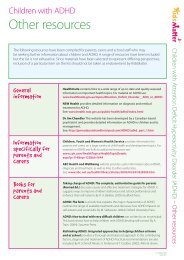
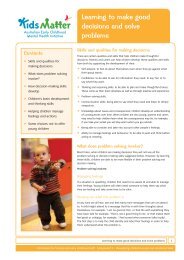
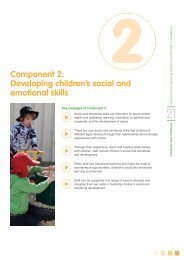
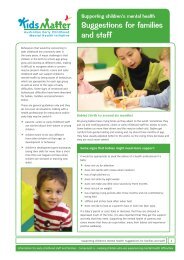
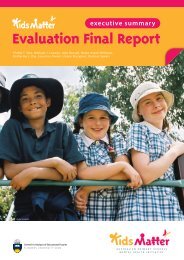

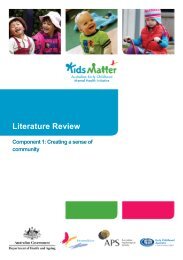
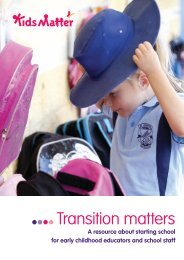
![Trinity Anglican School - Cairns story [378KB]pdf - KidsMatter](https://img.yumpu.com/41716076/1/184x260/trinity-anglican-school-cairns-story-378kbpdf-kidsmatter.jpg?quality=85)
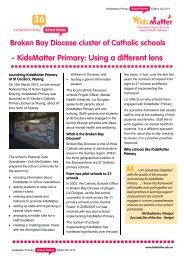
![Happy families work together [327KB] PDF - KidsMatter](https://img.yumpu.com/40767384/1/184x260/happy-families-work-together-327kb-pdf-kidsmatter.jpg?quality=85)
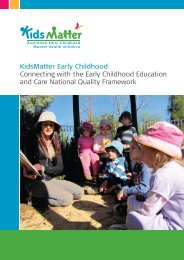
![Action Team Handbook 2012 [1.9M] [PDF] - KidsMatter](https://img.yumpu.com/38050920/1/184x260/action-team-handbook-2012-19m-pdf-kidsmatter.jpg?quality=85)
![[1008KB]pdf - KidsMatter](https://img.yumpu.com/38050895/1/184x260/1008kbpdf-kidsmatter.jpg?quality=85)
